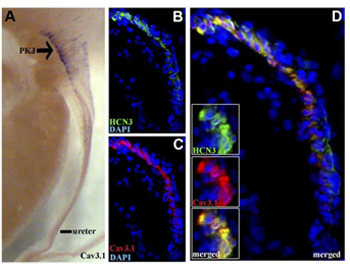Overview
- Peptide MDEEEDGAGAEESGQPRSFTQL(C), corresponding to amino acid residues 1-22 of rat CACNA1G (Accession O54898). Intracellular, N-terminus.

 Western blot analysis of rat brain membranes:1. Anti-CACNA1G (CaV3.1) Antibody (#ACC-021), (1:200).
Western blot analysis of rat brain membranes:1. Anti-CACNA1G (CaV3.1) Antibody (#ACC-021), (1:200).
2. Anti-CACNA1G (CaV3.1) Antibody, preincubated with CACNA1G/Cav3.1 Blocking Peptide (#BLP-CC021).
 Expression of CACNA1G in rat cerebellumImmunohistochemical staining of rat cerebellum using Anti-CACNA1G (CaV3.1) Antibody (#ACC-021). A. CACNA1G immunoreactivity (green) appears in the molecular layer. B. Nuclear staining using DAPI as the counterstain (blue). C. Merged images A and B. Mol = molecular layer.
Expression of CACNA1G in rat cerebellumImmunohistochemical staining of rat cerebellum using Anti-CACNA1G (CaV3.1) Antibody (#ACC-021). A. CACNA1G immunoreactivity (green) appears in the molecular layer. B. Nuclear staining using DAPI as the counterstain (blue). C. Merged images A and B. Mol = molecular layer.- Human myometrium (1:200) (Blanks, A.M. et al. (2007) J. Physiol. 581, 915.).
- Human myometrium cells (1:200) (Blanks, A.M. et al. (2007) J. Physiol. 581, 915.).
- Serrano, J.R. et al. (1999) J. Gen. Physiol. 114, 185.
- Perez-Reyes, E. (2003) Physiol. Rev. 83, 117.
- Andreasen, D. et al. (2000) Am. J. Physiol. 279, F997.
Voltage-dependent Ca2+ channels provide a pathway for rapid influx of Ca2+ into cells, which plays a crucial role in both electrical and metabolic signaling.1
T-type currents are transduced via channel proteins encoded by three genes that compose a subfamily within the CaV channel family.2-3
The activity of T-type channels contributes to several known physiological and pathophysiological phenomena including burst firing in neurons, pacemaking activity in the heart and secretion from endocrine tissues.2 There are three cloned T-type channel isoforms.
CACNA1G (CaV3.1) and CACNA1H (CaV3.2) are widely distributed whereas the expression of CACNA1I (CaV3.3) is restricted to the central nervous system.2
CACNA1G and CACNA1H are also expressed in the kidney, but little is known about their physiological role there.
Application key:
Species reactivity key:
Anti-CACNA1G (CaV3.1) Antibody (#ACC-021) is a highly specific antibody directed against an epitope of the rat CaV3.1 channel. The antibody can be used in western blot, immunocytochemistry, and immunohistochemistry applications. It has been designed to recognize CACNA1G from human, rat, and mouse samples.

Expression of CaV3.1 in mouse pelvis kidney junction.
Immunohistochemical staining of mouse kidney sections using Anti-CACNA1G (CaV3.1) Antibody (#ACC-021). A. CaV3.1 (purple) is detected in the pelvis kidney junction (PKJ). B. HCN3 staining (green), a marker of pacemaker cells, is detected in the PKJ. C. Same section stained for CaV3.1 (red). D. Merge of B and C panels shows high degree of co-localization between CaV3.1 and HCN3.
Adapted from Hurtado, R. et al. (2014) with permission of Federation of American Societies for Experimental Biology.
Applications
Citations
 Upregulation of CACNA1H under hypoxia.Immunocytochemical staining of rat pulmonary artery smooth muscle cells (PASMCs) and rat pheochromocytoma cells (PC12) using Anti-CaV3.2 (CACNA1H) Antibody (#ACC-025) and Anti-CACNA1G (CaV3.1) Antibody (#ACC-021). Staining shows upregulation of CACNA1H and not CACNA1G in response to oxygen stress.
Upregulation of CACNA1H under hypoxia.Immunocytochemical staining of rat pulmonary artery smooth muscle cells (PASMCs) and rat pheochromocytoma cells (PC12) using Anti-CaV3.2 (CACNA1H) Antibody (#ACC-025) and Anti-CACNA1G (CaV3.1) Antibody (#ACC-021). Staining shows upregulation of CACNA1H and not CACNA1G in response to oxygen stress.
Adapted from Sellak, H. et al. (2014) with permission of the American Physiological Society.
- Immunocytochemical staining of mouse endothelial cells. Tested in CaV3.1-/- mice.
Gilbert, G. et al. (2017) Biochem. Pharmacol. 138, 61.
- ND7/23 cell lysate (1:500).
Mitani, K. et al. (2016) J. Pharmacol. Sci. 130, 177. - Mouse heart lysate.
Walton, R.D. et al. (2016) J. Gerontol. A Biol. Sci. Med. Sci. 71, 1005. - Mouse brain lysates (1:1000).
Rice, R.A. et al. (2014) Neurobiol. Aging 35, 1002. - Mouse HL-1 cells.
Nguyen, N. et al. (2013) Biochim. Biophys. Acta 1833, 1294.
- Rat retinal whole mounts (1:200).
Fernandez, J.A. et al. (2015) Invest. Ophtalmol. Vis. Sci. 56, 5125. - Mouse kidney sections (1:700).
Hurtado, R. et al. (2014) FASEB J. 28, 730. - Rat heart sections (1:20).
Atkinson, A.J. et al. (2013) J. Am. Heart Assoc. 2, e000246. - Human myometrium (1:200).
Blanks, A.M. et al. (2007) J. Physiol. 581, 915.
- Mouse endothelial cells. Tested in CaV3.1-/- mice.
Gilbert, G. et al. (2017) Biochem. Pharmacol. 138, 61. - Rat pulmonary artery smooth muscle cells (PASMCs) and rat pheochromocytoma cells (PC12), (1:100).
Sellak, H. et al. (2014) Am. J. Physiol. 307, C648. - Human myometrium cells (1:200).
Blanks, A.M. et al. (2007) J. Physiol. 581, 915.
- Abd El-Rahman, R.R. et al. (2013) Am. J. Physiol. 304, H58.
- Rao, F. et al. (2013) Exp. Physiol. 98, 172.
- Levic, S. and Dulon, D. (2012) J. Neurophysiol. 108, 3116.
- Tzeng, B.H. et al. (2012) Cardiovasc. Res. 96, 533.
